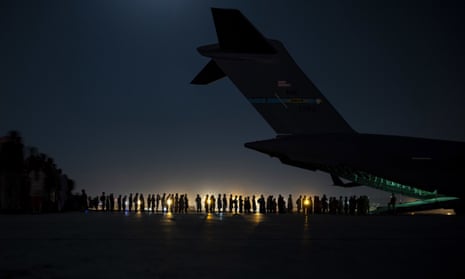As New Zealand begins to evacuate people from Afghanistan, those awaiting evacuation say they are struggling to reach the planes that would carry them to safety, and growing “more desperate with each passing day.”
“Access into Kabul airport is extremely difficult and travel into Kabul from the provinces is almost impossible,” minister of defence, Peeni Henare, said on Monday.
For New Zealand-bound people trapped in Kabul, getting to the airport is a bitter catch-22: it currently represents the only route to safety and refuge, but getting there at all puts them at greater risk. At least 20 people have already died in and around Kabul airport, many crushed by stampeding crowds or hit by stray bullets. On Monday, an Afghan guard was killed and three injured in a firefight involving US and German forces.
And for those trying to get on an evacuation plane, time may be running out. Taliban officials told Reuters last week that foreign forces had not sought to extend the end-of-August deadline to leave. On Monday, prime minister Jacinda Ardern warned that “the window to evacuate people out of Afghanistan is unfortunately very limited”.
“Despite our ongoing efforts we cannot guarantee we can assist all those who are seeking to evacuate,” Ardern said.
Chaos at the gates
Those waiting to be evacuated include New Zealand citizens, visa holders, and those who assisted troops during the occupation. Abdul*, a New Zealand citizen of Afghan descent, said his wife was trapped in Kabul, and has been granted an emergency visa to join him in New Zealand.
She has tried to reach the airport twice, but both times was unable to get inside the gates. The first time, she turned back after watching people get injured in the crush, he said. Taliban soldiers carried sections of PVC piping and used them to beat back the crowds – both his uncle and brother were beaten. The family watched a woman fall, hit her head, and then be trampled under a panicking crowd.
“These stampedes happen at the worst time possible. And anybody who’s on the way, whether it be big or small or a woman or a man or a child is just going to get hurt.”
At the other end of the phone line, Abdul could hear “just constant firing as I was speaking to her … the Taliban fighters were shooting up into the air, and also at the ground”. Three people around his wife were injured by ricocheting bullets.
“It got so dangerous I got worried for their health and safety … I told them to go back home.”

Ali*, an Afghan interpreter who worked for the New Zealand military, said he had not yet heard anything about the logistics of evacuation or reaching the airport. “We are getting more desperate with each passing day,” he said. “It’s horrendous here.
“The deadline for internationals troops to pull out is a week away and no clue if it’s going to be extended or not,” Ali said. “Time matters.”
Each attempt to reach the airport, Abdul says, puts his family in danger, both from the immediate threat of trampling, beatings and bullets in the crowds, and the longer-term fear that identifying oneself as an Afghan with connections to New Zealand could make them a target.
“Every time they have to go back home and come back, their lives are being put at risk.”
The large crowds mean even reaching one of the airport’s gates can take a full day of queueing. On her second attempt, Abdul’s wife stood for more than 10 hours trying to get to the gate. “At 1030 at night, they managed to reach the front of the line. And I relayed that information back to [New Zealand’s foreign affairs] and I said ‘hey can you please send defense force to pick these guys up’… and at the end I was told they are sorry. You’re in the wrong location – at 10.30 at night. I was told that you need to go somewhere else.”
Abdul called on the New Zealand government to provide a clearer plan to those attempting to reach the airport – clarity over which gate they need to attempt to reach, cut-off times for entry, how to identify themselves to allied troops, or whether they can gather at another meeting-point and be evacuated from there. Some Taliban patrols would demand to see documents, then give false information, telling evacuees that they needed a green card or that their visa documents were not valid. Evacuees needed clear instructions and directions, he said.
On Monday afternoon, the first evacuation flight to Aotearoa landed in New Zealand.
But it is not clear how many evacuees were on that plane. Unlike other nations, New Zealand is not providing numbers of how many people have been evacuated, citing privacy and security reasons. This also means, however, that there is no way of knowing how many of the 200 New Zealanders, or the 37-plus translators and Afghan workers who assisted troops have successfully been flown out.
In the meantime, Abdul says some families are beginning to lose hope. “We’re hoping it will work out on the third attempt. But we look at the news and we see that it’s not getting better and the New Zealand government isn’t putting in the right plan – you lose hope of ever seeing your family again.”
*Names have been changed due to concerns about possible retaliation.
